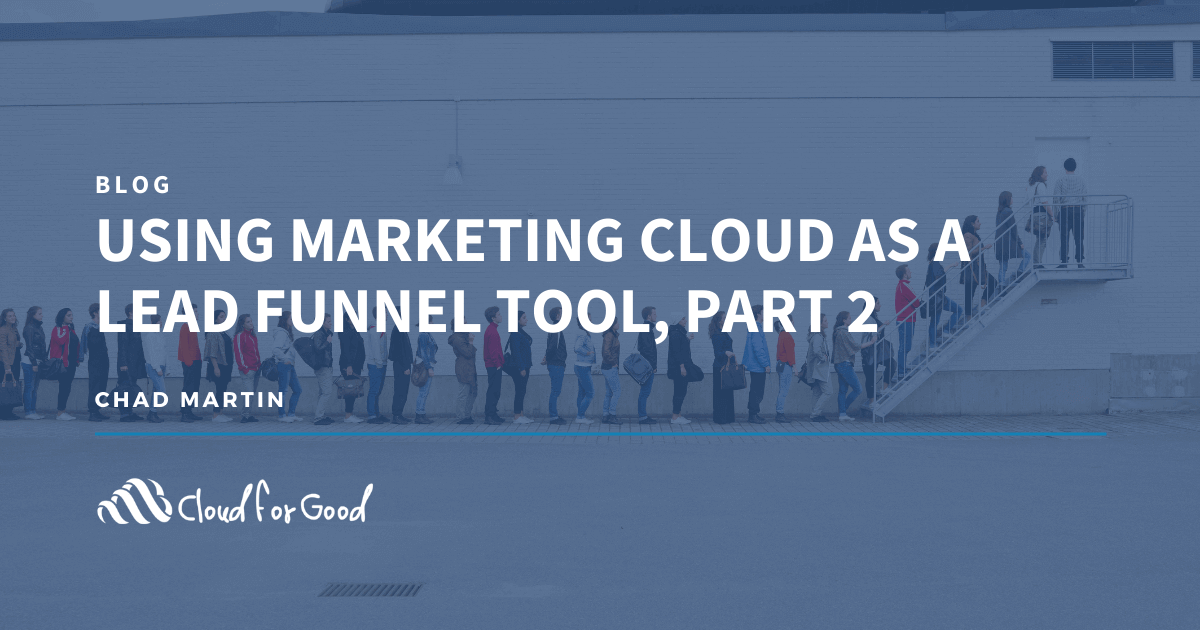Welcome back to our exploration of using Marketing Cloud as a lead funnel! If you haven’t yet, make sure to catch up on Part 1 of our two-part blog series. We last left off on how to remove duplicates in Marketing Cloud, and now we’re jumping right back into our deep dive on potential options for submitting data directly into the Marketing Cloud. Let’s get back into it.
DE Manager
Marketing Cloud’s DE Manager provides what is essentially a form handler (if you’re familiar with those in Pardot) endpoint that requires you to add code to the HTML for your form so that data can be sent to Marketing Cloud. You’ll also need to provide your Marketing Cloud account’s client ID and the data extension’s external key to make this happen. The positive about DE Manager is that since you are coding the HTML, and DE Manager is essentially a form handler feature, you can easily embed this code into any webpage. DE Manager has been around for a while and would not be considered the most secure method in regard to receiving submitted data. Anyone could recreate your form code and have data submitted to your data extension. This is an unlikely scenario, but a real possibility given that all the information needed for submitting to the data extension is available in the HTML. Being that this method is also an older technology, the risk is that it will eventually be deprecated.
CloudPages
Marketing Cloud provides an enhanced webpage building feature called CloudPages. This feature is used for all Subscription/Preference Centers built into Marketing Cloud, but it also can be used for any type of webpage or data capture.
CloudPages using Smart Capture
One particular CloudPage-specific Content Block used to easily build a form capture feature is called Smart Capture. The Smart Capture block is the (almost) perfect feature for easily building out a form inside Marketing Cloud for capturing lead/prospect data. What was with the “almost” perfect comment, you may ask? Smart Capture saves its form data directly into Marketing Cloud data extensions. As you now know, if you are integrating Sales Cloud or another CRM with Marketing Cloud, this may eventually lead to a duplicate record. This means that using the Smart Capture feature would likely then require the separate Journey to create the Contact in your Sales Cloud CRM and the corresponding Contact Delete process. CloudPages can be used standalone or embedded on your site using an iframe. CloudPages also need up to two SSL certificate purchases in order to achieve https:// for the images and CloudPage URL to be SSL secured. This applies to the following two CloudPages solutions mentioned in this article as well.
Custom CloudPages
Creating a custom CloudPage can provide a solution to almost any data capture problem. AMPScript, Server Side Javascript (SSJS), and even the API can be utilized to retrieve and insert data into Marketing Cloud, Sales Cloud, and even other external databases. So why is this not always the preferred solution? Custom CloudPage AMPScript code can be more difficult to create and maintain for the typical Marketer. Since Custom CloudPages are essentially all HTML and AMPScript code and do not have an easy-to-use form building feature – they generally require a Marketing Cloud Developer to create and a technical savvy marketer to modify. Custom CloudPages do have the added bonus of being able to save data directly to Sales Cloud, making them a great tool for utilizing Marketing Cloud as a lead funnel. Another consideration for CloudPages is that each impression will count towards your allotment of SuperMessages within Marketing Cloud.
Custom CloudPages as Form Handlers
A Custom CloudPage can also be developed specifically to receive a form submission from your form. This solution can work well in situations where you just want to change the <form action> of a current form on your site to a new destination (i.e. moving a form that was submitting to MailChimp to submit to Marketing Cloud instead). However, this solution may still require a Marketing Cloud Developer to help create the proper, secure AMPscript required to properly capture the information from your form. This solution would not be used as a standalone webpage or need to be embedded into your site.
FormAssembly / FormStack
FormAssembly and Formstack are popular form building tools that allow a non-coder to create forms that integrate with both Sales Cloud and Marketing Cloud. If you choose to insert the constituent data directly into Marketing Cloud, these solutions pose the same risks as mentioned before related to duplicate records.
API / SDK
The Marketing Cloud provides extensive API functionality with both SOAP and REST options (REST is the way of the future for Marketing Cloud APIs, so if you do implement an API solution, use REST). This advanced solution requires implementation on your web site, most likely by your web development team. The pro to this approach is you have complete control over the flow of the data and over the website look and feel. You could develop your form to make a call to retrieve a new ID before inserting the record into Marketing Cloud. The API solution could be considered the best solution if we all had a development team available to code our forms. Since most organizations do not have this access, this is generally reserved for forms that will not need to be modified for the long term. When implementing this method, consider Salesforce Marketing Cloud API maximum call limitations for your account type.
Capturing to your current database and pushing data to Marketing Cloud in batches
Another tried and true option for getting your form data into the Marketing Cloud is batch uploading of CSV files. If you go this route, then you are not really using Marketing Cloud as a lead funnel. Check out this article for more details on integrating Marketing Cloud with external applications.
Lead Scoring in Marketing Cloud
So, does Marketing Cloud have the ability to score a lead and sync it to Sales Cloud? Yes, Marketing Cloud can push records to Sales Cloud using a Salesforce Activity in Journey Builder. The lead scoring element is unfortunately not native functionality in the Marketing Cloud. However, there are a few ways to accomplish the concepts of lead scoring in a slightly less advanced way (than Pardot).
Use Journey Builder
If we have captured data from our web-to-lead or RFI forms, and this data now lives in Marketing Cloud, then we can take further action on these constituents by injecting them into a journey. In the example of a prospective student interested in applying, we can send them additional emails, or SMS messages. Depending on how the constituent responds, you can have different paths that turn this lead into a contact. Similarly, you could use Update features to create a scoring method.
Use Queries and Journey Builder
In the example above, we used different paths of a journey to help us identify what actions a constituent is taking, we could also create queries to look for different actions taken and create our own scoring data extensions. Depending on your scoring needs, this could be complex and is typically why clients will utilize Pardot’s built-in lead scoring features instead of creating their own system.
What about Einstein Engagement Scoring for all of my lead scoring needs?
Einstein Engagement Scoring is an AI feature of Marketing Cloud that uses subscribe information to identify likely categories a constituent might best fit into. These predictions:
- Email Engagement Prediction
- Subscriber Retention Prediction
- Email Open Prediction
- Email Click Prediction
- Web Conversion Prediction
These different predictions could potentially be utilized to help you better understand the likelihood of a constituent to take an action. However, they would not necessarily function in the same fashion as would lead scoring in Pardot. This feature is definitely worth exploring for your lead scoring needs.
Couldn’t I just insert data directly into Sales Cloud CRM?
Yes, this is absolutely an option if you are utilizing Sales Cloud as your CRM and is a recommended best practice. The benefits of this method would be generating a Contact ID for your constituents, which would ultimately minimize duplicates in Marketing Cloud. This also assumes that you have some duplicate checks in place within the CRM. This potentially takes out possible solutions above in regards to using Marketing Cloud features as a lead funnel tool (custom CloudPages and custom form handlers are the only options referenced above that would use Marketing Cloud features to insert directly into Sales Cloud).
Summary
Marketing Cloud is an excellent Marketing Automation tool and could be utilized as a lead funnel. There are some potential caveats in doing so, but potential workarounds can be implemented with some effort. Finally, Marketing Cloud is not yet known for its extensive lead scoring capabilities, but some capabilities do exist that could potentially solve your problem.





